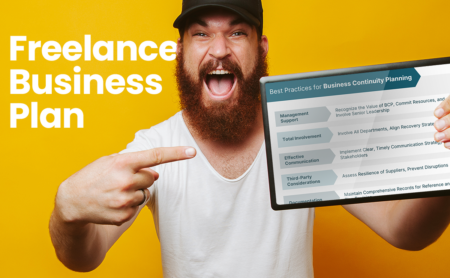So you want to know how to start a creative agency? That’s great! The creative industry is booming, and a lot of money can be made.
But it’s more complicated than creating a website and calling yourself a creative agency. There are a lot of things you need to do to make your business successful.
This article will walk you through the process step-by-step and show you how to start a successful creative agency that makes money. Let’s dive in!
👋 Psst...Have you seen the all-new Feedcoyote yet? They've got a new look, more freelance opportunities, and the best collaboration tool for freelancers! Join over 100,000 fellow freelancers who network, find clients, and grow their business with Feedcoyote. Join for Free »
What exactly is a Creative Agency?
First, we need to clearly understand what a creative agency is before we discuss starting one.
A creative agency is a company that provides creative services to clients. These services can include the following:
- Advertising
- Marketing
- Branding
- Design
- Web Development
Creative agencies typically have a team of employees who specialize in different areas of creative work. For example, an advertising agency might have a team of copywriters, art directors, and graphic designers.
The term “creative agency” describes many businesses, from small boutique firms to large multinational corporations.
How to Start a Creative Agency in 13 Steps
Here is your step-by-step blueprint for starting a creative agency.
1) Determine the Services You’ll Offer
When starting a creative agency, it’s essential to determine what services you can offer, who to target as clients, and how to position yourself in the market.
There are a few questions you can ask yourself to help narrow your focus:
- What are your strengths and weaknesses?
- What type of work do you enjoy most?
- What type of clients do you want?
Once you have a better sense of your strengths and interests, you can develop a specialty for the services your creative agency will offer.
Perhaps you want to position yourself as an expert in branding, or maybe you want to provide content marketing services to help small online businesses. Alternatively, you might want to focus on delivering creative solutions for tech startups.
Whatever focus you choose, make sure it is something you are passionate about and that there is a market for it. You must determine your focus to attract clients and grow your business.
2) Decide How You will Differentiate Yourself from the Competition
With such a saturated market, it’s not only important to know how to start a creative agency, but you also need to consider how you will differentiate your creative agency from the competition. There are several ways to do this.
- Focus on your target market and create a niche for yourself. By understanding your ideal client and what they need from an agency, you can position yourself as the go-to source for those services.
- Emphasize the culture of your agency. Creative agencies should be places where people feel inspired and supported in their work. By creating a positive, collaborative environment, you can attract top talent and build a reputation for excellence.
- Remember the power of word-of-mouth marketing. If you deliver great work and treat your clients well, they’ll be happy to recommend you to others.
By following these tips, you can set your creative agency apart from the rest.
3) Name Your Creative Agency
Creating a name for your creative agency can be exciting and daunting.
On the one hand, it’s an opportunity to brand your business and set it apart from the competition. On the other hand, finding a name that accurately reflects your creative vision can take time and effort.
Here are a few tips to help you get started:

- Brainstorm with your team. Get together with your partners or employees and brainstorm a list of possible names for your agency. After all, you know your agency best! Try to come up with as many ideas as possible, no matter how wild or far-fetched they may seem. You could even use a business name generator if you’re stuck. You never know where inspiration will strike!
- Do some research. Once you have a list of potential names, see if anyone else is using them. You want to avoid choosing a name already used by another business, which could lead to confusion or legal problems.
- Test out the name. Once you’ve settled on a name, try it out on potential customers or clients to see if it resonates with them. If they don’t react positively to the name, it may be time to return to the drawing board.
Follow these tips, and you’ll come up with a unique and suitable name that accurately represents your business in no time.
4) Create a Unified Brand Identity
Remember: the name or logo of your creative agency is only one part of your brand!
You can create your brand identity yourself. Here are the main elements:
- A logo. A logo is often the most recognizable part of a brand identity, so it’s essential to ensure it’s high quality and memorable.
- A business website. Your business website is most likely the first interaction potential clients or customers will have with your brand, so make sure it makes a good impression. Make sure it’s user-friendly, and take advantage of website builder tools.
- A style guide. This document will define your brand’s overall look and feel, including the color palettes, fonts, and tone used in your marketing materials.
- Social media accounts. With social media being such a powerful marketing tool, it’s essential to ensure your accounts are up-to-date and reflect the overall style of your brand.
If you feel you don’t have the time or skills to create your brand identity, the other option is you can hire creative agencies to help you develop a unified brand identity.
By working with you to understand your business and your customers, they can create a brand that reflects your values and resonates with your target audience. They will also help you to determine the best way to communicate your brand across all channels, from your website and social media to traditional advertising and marketing materials.
5) Decide on Working Remotely or having a Physical Office

In today’s business climate, more and more agencies are moving to a remote office model as physical locations typically require a higher overhead cost.

Here are some factors to consider for your agency:
- How big is your agency? It may not be worth a physical office space if your team is small.
- What type of work do you do? If you do more collaborative work, having an office space may justify having a physical office space.
- Can you afford it? Renting or buying an office will be added to your list of business expenses. The money you spend on renting an office space is money that won’t go towards something like marketing that may give your agency a higher revenue. Is it worth it?
- Are office spaces available? If there are none available in your proximity, it may not be worth looking into in the first place. Remember to check coworking spaces.
- What do your employees prefer? Some workers may prefer the flexibility and freedom that comes with working from home, while others may find that they are more productive in a traditional office setting.
Ultimately, the best way to decide whether a remote or physical office is right for your agency is to weigh the pros and cons carefully and make a decision that aligns with your business goals.
If you choose to work from home, have a room designated as a home office and a place to relax and forget about work. If that’s not possible, at least have a designated area separate from where you like to wind down.
Choosing a Location for your Agency Headquarters
Here are some tips when choosing a location if you want a physical office for your agency headquarters:

- Make sure the area is central and easily accessible for all your employees.
- Check that the space is large enough to accommodate your needs and has the necessary amenities (like meeting rooms and a kitchen).
- Consider the cost of renting or purchasing the space.
6) Get your Company Licensed & Obtain Permits
Here comes the no-so-fun (but necessary) stuff.
Does your Company need a License?
You may need to get your company licensed if you’re doing business in the United States. There are a few different ways to tell if this is the case.
- Check your State’s requirements. Each State has its laws and regulations regarding businesses, so you’ll need to find out the specific requirements where you’re located. You can usually find this information on your State government’s website.
- Consider whether your business activities fall under any Federal licensing requirements. For example, businesses that deal with firearms or alcohol must be licensed at the Federal level.
- Consider whether you need any specialized licenses or permits depending on the nature of your business. For example, companies that provide healthcare services must obtain specific licenses before they can operate legally in the US.
If you’re unsure whether your company needs to be licensed, it’s always a good idea to consult with an attorney or other legal professional specializing in business law. They’ll be able to advise you on the specific requirements for your business.
Obtaining a Business License in the United States
The process of obtaining a business license in the United States can vary depending on the type of business and the State in which it is located. However, there are a few general steps that all businesses will need to follow.
- Register your business with the appropriate government agency. This may be the Secretary of State’s office, the Department of Revenue, or another local department.
- Obtain a business license from the appropriate licensing authority. In some cases, this may be a city or county agency, while in others, it may be a state-level agency.
- Remember to renew your license on an annual basis. The requirements for doing so will vary depending on the issuing agency, but they typically involve submitting a new application and paying a renewal fee.
By following these steps, you can obtain the licenses and permits needed to operate your business legally in the United States.
7) Form a Legal Business Entity

A legal entity is a business separate from its owners in the eyes of the law. This means the business can be held liable for debts and obligations rather than the owners.
There are a few steps to forming a legal entity. The first is to choose the type of entity that you would like to create. This can be a corporation, limited liability company (LLC), sole proprietorship, or partnership. Here’s the difference between them:
- A corporation is a legal entity owned by shareholders and overseen by a board of directors. A corporation is typically large and offers public shares.
- A limited liability company (LLC) is a business structure offering its owners limited liability protection. These offer tax benefits, legal protections, and excellent growth potential.
- A sole proprietorship is a business owned and operated by one person. These don’t offer complete personal liability protection and are limited in their growth potential. However, there is minimal paperwork involved and low costs for setup.
- A partnership is a business owned and operated by two or more people.
Each type of business has its advantages and disadvantages. For example, a corporation offers limited liability protection to its shareholders but also has complex formalities to follow.
Understanding the difference between these types of businesses can help you choose the proper structure for your own business.
Once you have decided on the entity type, you will need to file the appropriate paperwork with the State in which you are forming the entity. You will also need to choose a name for your entity and register it.
After the paperwork has been filed and the entity registered, you will need to obtain the necessary licenses and permits. After taking all these steps, you will officially form your legal entity.
You should create a legal entity when ready to start doing business. This will protect you and your business from liabilities, and it will make it easier to obtain financing and licenses.
8) Open a Business Bank Account & Get a Business Credit Card
Opening a business bank account helps you manage your finances, makes it easier to pay taxes and helps build business credit. This can be done in two simple steps.
Step 1: Research
First, research different banks and compare their fees, services, and features. You should also read online reviews to understand what other businesses think of the banks you’re considering.
Once you’ve chosen a bank, you’ll need to gather some documents. These will likely include your business license or incorporation papers and your Social Security number or Taxpayer Identification Number.
Step 2: Open an Account
Next, you’ll need to open an account with the bank. This process will vary depending on the bank, but you may be able to do it online, over the phone, or in person.
You’ll want to open your business bank account using dedicated business banking for personal asset protection. You always want to keep your personal and business accounts separate in case your business ever gets sued, in which case your personal assets like your home and car could be at risk.
Once your account is open, you’ll be able to deposit money into it and start using it to manage your finances. Remember to keep track of your transactions and monitor your balance so that you don’t overdraw your account.
Opening a business bank account is a necessary step for most businesses in the United States. By researching and gathering the required documents, you can open an account quickly and manage your finances more effectively.
Open Net 30 Accounts
Net 30 accounts are vendor accounts that give a business 30 days to pay off an invoice.
This type of account can help businesses manage their cash flow by giving them more time to generate revenue. In addition, major business credit bureaus often consider a business’s ability to pay its invoices on time when calculating its credit score.
As a result, maintaining a good payment history on net 30 accounts can help businesses build their credit scores and access better terms in the future.
9) Register for Taxes
Before opening for business, you’ll need to register for State and Federal taxes.
First, you’ll need to gather all the necessary documentation, including your Social Security Number and bank account information. Once you have everything you need, you can begin the registration process.
Next, you’ll need to apply for an Employer Identification Number (EIN) with the IRS. You can do this online at the official IRS website. Just create an account and provide basic information about yourself and your business.
Once submitted, you’re done! The process is relatively straightforward and can be completed in minutes.
10) Set up Business Accounting Services
Regarding accounting and tax filing for your business, there are a few different options available.
You can do everything yourself, of course, but unless you have experience in accounting, this isn’t always the best option.
Alternatively, you can hire an accountant or bookkeeper to handle your finances. This can be a great option if you don’t have the time or knowledge to do everything yourself, but it can be expensive.
You can also sign up for accounting software that will help you track your finances and file your taxes. This option is often more affordable than hiring someone, and it can be less time-consuming as well.
Whichever method you choose, ensure that you stay on top of your accounting so your business can run smoothly.
11) Create a Business Plan
Now that you have everything in place, it’s time to develop a business plan to ensure your creative agency is successful.
A business plan is a formal document that outlines the goals and objectives of a business. It includes information about the company’s products or services, target market, and financial projections.
Business plans are typically created by the company’s Founders or Senior Executives. However, they can also be developed by outside consultants.
A business plan can be divided into four main steps: research, analysis, planning, and writing.
- Research your industry and your target market. This will help you to understand the sector in which your business will operate and the needs of your potential customers.
- Analyze your competition and develop strategies for differentiating your business. This step is critical in ensuring your business has a unique selling proposition.
- Develop a realistic plan for achieving your goals. This will involve setting milestones and timelines for each objective.
- Put your plan into writing. This step will help to ensure that all stakeholders are on the same page and that your business plan is clear and concise.
12) Bring in New Business
Once you have a business plan with clear, actionable steps and objectives, it’s time to take action. There are several ways to bring in new business, and focusing on one method at a time is essential, so you don’t spread yourself too thin.
One popular option is advertising. You can do this through traditional advertising involving print, television, radio, and digital advertising through social media and Internet ads.
Another way is through organic reach online. You can do this by posting on social media or ranking for popular keywords on a blog. This method may take longer than paid advertisements, but it’s free and worth it if done correctly and consistently.
You can also attract new business through word-of-mouth. While this is a traditional approach, you can modernize it with the use of digital business cards. Verbally sharing your business with people face-to-face can be very effective as it is free and can reach the closest people in your life.
Finally, many businesses also offer promotions or discounts to new customers to entice them to try their products or services.
By combining these methods over time, businesses can generate interest and excitement to a wide range of people.
13) Start Hiring

Once you get the ball rolling and bring in some revenue, it’s time to start hiring.
The best places to find new team members for your creative agency are through online job boards or by word-of-mouth. You can also ask other businesses in your industry if they know anyone looking for a new opportunity.
When hiring, taking your time to find the right fit for your team is essential. After all, these people will be responsible for helping your business grow and succeed.
Consider starting slow by outsourcing people part-time, and as you accumulate income, hire full-time employees that will be the team members that work alongside you. Make sure to conduct interviews and check references before making any hires.
Creative Agencies vs. Agencies: What’s the Difference?
Creative and non-creative agencies are professional services firms with some critical differences.
Creative agencies tend to focus more on the conceptual side of things, developing creative ideas and strategies to help their clients achieve their objectives. Advertising agencies, on the other hand, are more focused on the execution of marketing campaigns. They work with their clients to develop ad campaigns implemented across various channels, such as television, radio, print, and digital.
Both agencies offer multiple services but differ in their approach and focus.
Is a Career as an Agency Founder Right for you?
Now that we understand what a creative agency is, the next step is to determine whether this is the right choice for you.
Starting a creative agency is not for everyone, so this begins by asking yourself a series of questions:
- What are your core motivations for starting a creative agency?
- Do you have the necessary skills (like sales, marketing, business management, and leadership qualities) to run a successful agency?
- Are you prepared to make sacrifices (like working long hours and forgoing a steady paycheck)?
- What is your definition of success?
- How much risk are you willing to take?
These are essential questions to answer because they will help you determine whether starting a creative agency is the right decision for you.
How Do Creative Agencies Make Money?
Creative agencies make money by selling their creativity and expertise to clients. One critical way they make money is by consistently getting leads. Once a lead has converted into a client, they determine how they will charge the client, which varies from hourly rates, project fees, or retainer fees.
Hourly rates are based on the number of hours spent working on a project. Project fees are charged for the entire project, regardless of the number of hours spent working on it. Retainer fees are monthly payments a client makes to an agency in exchange for a certain number of work hours or deliverables each month.
Many agencies also earn revenue from selling products and services such as books, workshops, and consulting services.
Is It Hard to Start a Creative Agency?
Yes, it can be challenging to know how to start a creative agency.
Many people interested in creating their agency need help getting started because they need the right connections or help to figure out how to get their foot in the door. Finding funding for a new agency can take time and effort, as most investors are interested in more established companies.
However, overcoming these obstacles and successfully launching a creative agency is possible. The key is having a clear company vision, building strong relationships with potential clients and investors, and always learning and growing.
With dedication and hard work, anything is possible, including starting a successful creative agency.
Conclusion
So, there you have it. Everything you need to know on how to start a creative agency from scratch!
It won’t be easy – nothing worth having ever is – but if you put in the hard work and follow these simple steps, you can make your dream of owning a profitable creative business a reality.
Are you ready to get started?
Keep the conversation going...
Over 10,000 of us are having daily conversations over in our free Facebook group and we'd love to see you there. Join us!



